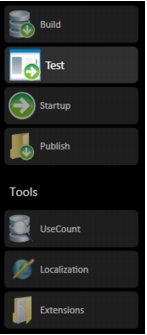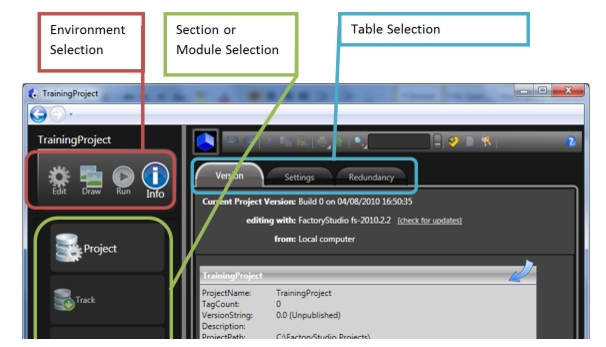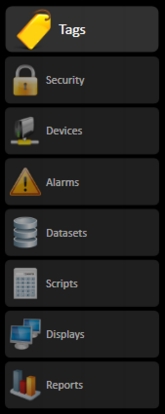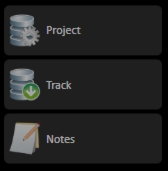Navigating in the Workspace
You navigate in FactoryStudio using the workspace environment, sections and tabs.
Any Engineering workspace user interface is, therefore, identified by 3 names: the Environment (main menu on top left), the Section (or sub-menu) and the Tab (or Table)
To describe how to get to a specific location where you perform functions, we use a shorthand notation.
For example, rather than saying:
Click Edit, then click Tags, then click the Objects tab.
We say:
Go to Edit > Tags > Objects.
This shorthand notation quickly tells you how to navigate to the correct main menu, sections, and tabs.
 To configure the basic elements of your project, from the Main Menu, click on the “Edit” icon.
To configure the basic elements of your project, from the Main Menu, click on the “Edit” icon.
Define/Edit Tags to use in the project.
Define User permissions and Project access levels.
Configure Communication Protocols and Device Data Acquisition.
Configure Alarm Tags and Alarm Groups to generate Alarms under defined conditions.
Define data sources such as Files, Databases, Specific Tables, Pre-defined queries.
Configure .NET Scripts in VB.NET or C-Sharp.
Select dynamic graphical displays to configure.
Configure Reports, which including updated graphical symbols, in XPS, PDF, HTML, ASCII, and Unicode formats.
 To configure dynamic displays, select the Display on Edit-Displays and click on the Draw icon to access the graphical Designer.
To configure dynamic displays, select the Display on Edit-Displays and click on the Draw icon to access the graphical Designer.
 The Run environment provides access to all project execution commands
The Run environment provides access to all project execution commands
Prepare a Project for execution and save the project's Build history.
Testing the project provides a way to see the project in action before publishing it to the server for use.
Run the project configuration in production mode.
Publish the Project to enable its final installation. Increment the project Publish Revision numbers.
Tallies the number of times Tags are used in the project. Provides project objects cross reference.
Customize your project to use other languages in Alarm Messages and Display text.
Import configuration data already created for OPC Servers, any configuration table, or an entire project.

Provide access to current Project information.
Project and product Version, location of project, Local Language, License information.
Find information regarding published project release number and project changes.
Leave arbitrary notes for other project engineers.


 To configure the basic elements of your project, from the Main Menu, click on the “Edit” icon.
To configure the basic elements of your project, from the Main Menu, click on the “Edit” icon. 
 To configure dynamic displays, select the Display on Edit-Displays and click on the Draw icon to access the graphical Designer.
To configure dynamic displays, select the Display on Edit-Displays and click on the Draw icon to access the graphical Designer.  Prepare a Project for execution and save the project's Build history.
Prepare a Project for execution and save the project's Build history.  Provide access to current Project information.
Provide access to current Project information.